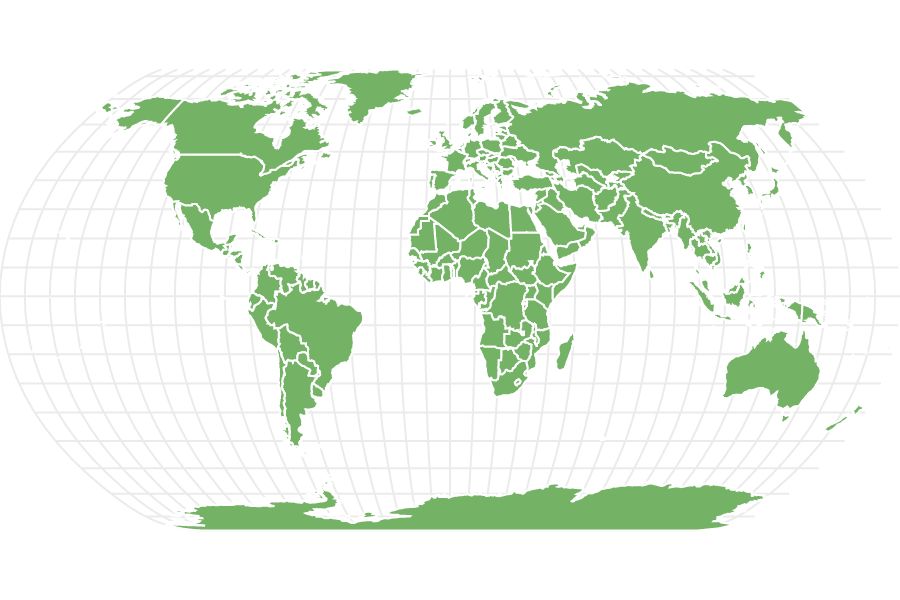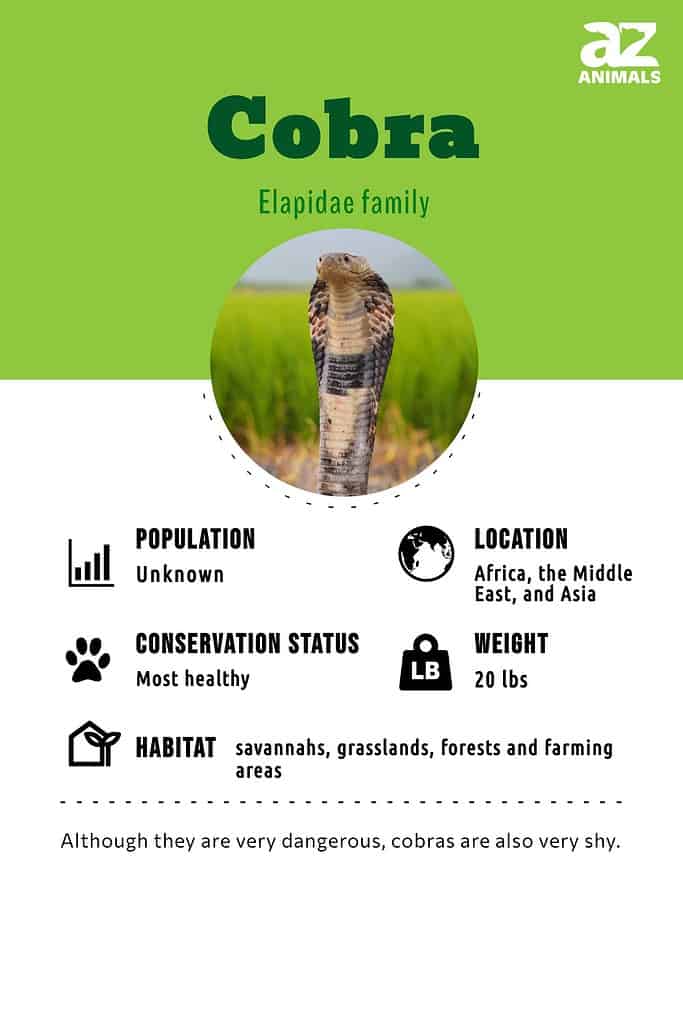Cobras
Several medicines have been created using cobra venom.
Advertisement
Cobras Scientific Classification
Read our Complete Guide to Classification of Animals.
Cobras Conservation Status

Cobras Facts
- Prey
- Mice, rats, frogs, toads, lizards, eggs, snakes
- Main Prey
- Depends on the species, but rodents for most species.
- Group Behavior
- Solitary except during mating season
- Fun Fact
- Several medicines have been created using cobra venom.
- Biggest Threat
- Habitat destruction and persecution by humans.
- Most Distinctive Feature
- Hood that they spread when threatened.
- Litter Size
- 3-25
- Diet for this Fish
- Omnivore
- Lifestyle
- Diurnal
- Number Of Species
- 37
- Location
- Africa, Asia, Middle East
View all of the Cobras images!
Cobras are highly venomous snakes that inhabit various habitats in Africa, the Middle East, and Asia.
Many can spit venom accurately from several feet away and spread the skin around their heads and necks into a hood to appear larger.
Amazing Facts About Cobras

- They create hoods by flattening their ribs and stretching out the skin.
- Many can spit venom at predators, and some of the venoms cause burns to the eyes or broken skin.
- Although they are very dangerous, cobras are also very shy.
- After taxonomic revision in 2009, there are 38 species of snakes included in the Naja genus, but there may be more as scientists do more research.
- The Caspian cobra and the Philippine cobra are the most venomous of all cobra species.
Where to Find Cobras

Cobras spread their ribs and muscles at their necks to stretch their skin into a hood.
©Eugene Troskie/Shutterstock.com
These snakes inhabit areas of rainforest and cultivated areas, they’re also found in deciduous forests, rice paddies, and sometimes urban areas. Some species, like the Arabian cobra, live in temperate climates with open savannahs and grasslands; still, others prefer arid climates.
Most cobra species are diurnal, and active during the day. In areas where temperatures soar during the summer, they shift their hunting habits to the early morning and late evening. Cobras, like other snakes, primarily eat rats and mice, but also take amphibians, lizards, birds, and their eggs, and the king cobra eats other snakes.
These snakes mate in the spring, the timing of which depends upon whether they’re in the northern or southern hemisphere. They lay their eggs and bury them in leaves and dirt to help maintain a consistent temperature. Most species guard their eggs, but the king cobra mother builds a nest and then stays there to incubate them until the eggs hatch. Rinkhals, however, give live birth.
Scientific Name

Our common name for cobras was originally
cobra de capello, and means “hooded serpent.”
©Skynavin/Shutterstock.com
All cobras are members of the Elapidae family of snakes. These snakes are highly venomous; some of their cousins are mambas and coral snakes. In 2009, several elapids were reclassified, and a couple of them, including the water cobras and burrowing cobra of the Boulengerina subgenus. In doing so, the Naja genus grew to 38.
The genus Naja came from Sanskrit in the form of nāga; in Sanskrit, nāga is pronounced with a hard ‘g’ sound. Some believe it means snake, but others believe it’s a word that means hairless or naked.
Our common name for cobras was originally cobra de capello, and means “hooded serpent.” The Portuguese brought the term back from their travels when they first encountered the animal, but “Cobra” has its roots in Latin. Over time, the common name was shortened to just “cobra.”
Population and Conservation Status
According to the IUCN, of the 38 known cobra species, several are vulnerable, near threatened, or endangered, but most have healthy populations. While some species are decreasing in number, some are increasing or have stable populations. Areas, where the cobras live in remote or protected habitats, have stable populations. Many survival threats involve habitat destruction and being killed out of fear.
Cobras have few natural predators aside from people, but they are actively hunted by mongooses and boars. Both animals eat their eggs, but the mongoose is actually immune to their venom and cobras are a fairly regular part of their diet.
Appearance and Description

The large hood on the neck of the Indian cobra is marked with black and white.
©iStock.com/insaneDynamix
Cobras are highly venomous snakes that are typically long, slender snakes reaching six to ten feet long, and king cobras can be 18 feet long. They have round pupils, varying head shapes, and a wide array of color patterns.
When a cobra spits venom, it’s more that they squeeze it out through their fangs. They have strong muscles that forcibly expel venom through their fangs. Many cobras have an opening on the front of their fangs which allows the venom to come out there, instead of the inside. Their fang structure varies; but except for the Indian cobra and Caspian cobras, all can spit venom to some degree.
Their hoods are defensive features that make them appear larger to a predator. However, many cobras forage with their heads up and off the ground to see better. Many cobras hiss and growl when threatened, but they are more inclined to seek escape than attack.
Types of Cobras

The Yellow Cobra spreads a wide hood in defense when threatened or confronted.
©Parichatphoto/Shutterstock.com
True Cobras inhabit areas of Africa, Asia, the Middle East, and Indonesia. They vary in length and color pattern, but all have hoods and raise up to one-third of their body off the ground.
- Chinese Cobra (N. atra)
- Egyptian Cobra (N. haje)
- Equatorial Spitting Cobra (N. sumatrana)
- Forest Cobra (N. melanoleuca)
- Indian Cobra (N. naja)
- Monocled Cobra (N. kaouthia)
- Philippine Cobra (N. philippinensis)
- Red Spitting Cobra (N. pallida)
- Snouted Cobra (N. annulifera)
- Yellow Cobra (N. nivea)
- Zebra Spitting Cobra (N. nigricincta)
King cobras and Rinkhals aren’t true cobras but look similar and are equally dangerous.
King Cobra Ophiophagus hannah – this snake eater used to be counted among the Naja group. However, genetic research and morphology show that it is its own species.
Rinkhals (Hemachatus haemachatus) – Also known as the Ring-Necked Spitting Cobra, a rinkhals has keeled scales and only lives in South Africa and Zimbabwe. It’s not a true cobra but looks similar.
Evolution and History
Many scientists have studied the venom of cobras and its potency. The snakes’ venom glands have co-opted proteins that originally play mundane roles elsewhere in their bodies. This innovation was needed to help them stay ahead of the animals they eat, which would develop resistance to their venoms over time.
There also is research done about how the spitting technique evolved in cobras, which could have resulted as a technique against larger animals and those with the ability to hit the snakes with large objects, such as our human ancestors.
Venom: How Dangerous are Cobras

Many cobras can spit venom – and with terrific aim.
©Eugene Troskie/Shutterstock.com
These snakes are extremely dangerous and should be admired from a distance. A bite from one can mean death after very painful symptoms. Most elapids like cobras have strongly neurotoxic venom, however, those species that spit venom also have cytotoxins that can cause blistering.
Cobra snakebite envenomation symptoms depend on the species and can include drowsiness, nausea, vomiting, violent abdominal pain, cramps, swelling, bruising, blistering around the site of the bite, labored breathing, rapid heart rate, weak pulse, and diarrhea.
If you are bitten by a cobra or one of its cousins, seek treatment immediately.
Venom in Medicine
Cobra venom is highly valuable to medical research. Several medicines including blood thinners and heart medications have been created using some of the components in venom, and anticancer and anti-inflammatory medicines are being created and tested.
Venomics, the study of venom, is an exciting field with a lot of potential to help people in the future.
Cobra Behavior and Humans

Cobras can raise up to one-third of their body length off the ground.
©FunnyDive/Shutterstock.com
Cobras and their hooded cousins are often shy and would rather flee than fight. These snakes aren’t generally aggressive, but they will defend themselves. Some are known to stand their ground and even defend their nests from predators.
Although these snakes seem frightening, they are an integral part of the natural balance. Without cobras and other snakes, we would be overrun by rodents.
View all 235 animals that start with CCobras FAQs (Frequently Asked Questions)
Are cobras venomous?
Yes! These snakes produce some of the most toxic venoms of all snakes.
Where do cobras live?
Cobras live in a wide variety of habitats, from open grassland to primary rainforest.
How do cobras hunt?
Most cobras are active foragers and quietly stalk their prey during daylight hours.
What do cobras eat?
Cobras eat a lot of rodents, but they also eat frogs, lizards, and other snakes.
What are the differences between a cobra and a cottonmouth?
The main differences between a cottonmouth and a cobra are their size, venom, and distribution.
Thank you for reading! Have some feedback for us? Contact the AZ Animals editorial team.
Sources
- Rinkhals | African Snakebite Institute, Available here: https://www.africansnakebiteinstitute.com/snake/rinkhals/
- Egyptian Cobra | African Snakebite Institute, Available here: https://www.africansnakebiteinstitute.com/snake/african-snakes-egyptian-cobra/
- King Cobra | UCSD Toxicology, Available here: http://toxicology.ucsd.edu/Snakebite%20Protocols/Ophiopha.htm
- Indian Cobra | UCSD Toxocology, Available here: http://toxicology.ucsd.edu/Snakebite%20Protocols/Naja2.htm
















